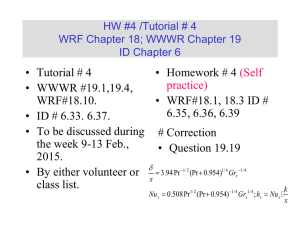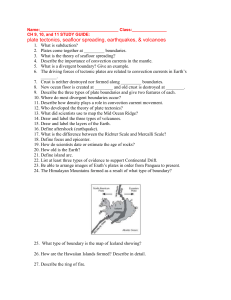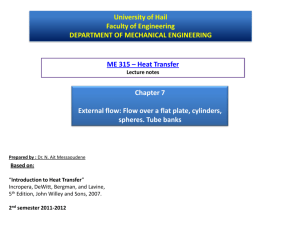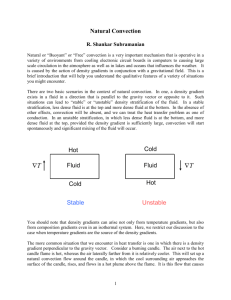ME315 071 chapter6
advertisement
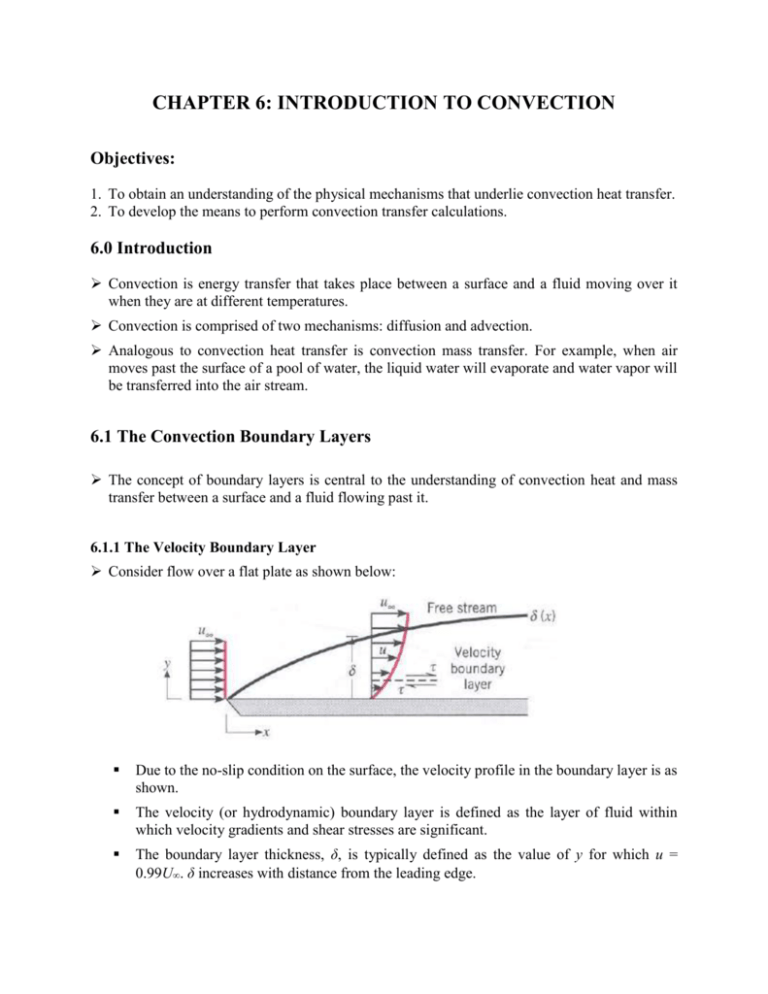
CHAPTER 6: INTRODUCTION TO CONVECTION Objectives: 1. To obtain an understanding of the physical mechanisms that underlie convection heat transfer. 2. To develop the means to perform convection transfer calculations. 6.0 Introduction Convection is energy transfer that takes place between a surface and a fluid moving over it when they are at different temperatures. Convection is comprised of two mechanisms: diffusion and advection. Analogous to convection heat transfer is convection mass transfer. For example, when air moves past the surface of a pool of water, the liquid water will evaporate and water vapor will be transferred into the air stream. 6.1 The Convection Boundary Layers The concept of boundary layers is central to the understanding of convection heat and mass transfer between a surface and a fluid flowing past it. 6.1.1 The Velocity Boundary Layer Consider flow over a flat plate as shown below: Due to the no-slip condition on the surface, the velocity profile in the boundary layer is as shown. The velocity (or hydrodynamic) boundary layer is defined as the layer of fluid within which velocity gradients and shear stresses are significant. The boundary layer thickness, δ, is typically defined as the value of y for which u = 0.99U. δ increases with distance from the leading edge. The velocity gradient in the boundary layer is associated with shear stresses τ acting in planes that are parallel to the fluid velocity. For a Newtonian fluid, the surface shear stress is s u y y 0 (1) where μ = dynamic viscosity. The frictional drag on the plate may be determined from the local friction coefficient, given as Cf s U 2 2 (2) Since δ = δ(x), u y y 0 depends on the distance x from the leading edge of the plate. Therefore, τs and Cf also depend on x. 6.1.2 The Thermal Boundary Layer Consider flow over an isothermal flat plate as shown below: Due to the difference in temperature between the fluid in the free stream and the surface of the plate, temperature gradient develops in the fluid as shown. The region of fluid in which the temperature gradient exists is called the thermal boundary layer. The thermal boundary layer thickness, δt, is typically defined as the value of y for which the ratio [(Ts-T)/(Ts-T)] = 0.99. δt increases with distance from the leading edge. The condition in the thermal boundary layer determines the convection heat transfer coefficient. This is illustrated below. At any location x on the plate, there is no fluid motion and energy transfer occurs only by conduction. Therefore, the local heat flux is obtained from Fourier’s law as qs k f where kf = thermal conductivity of fluid. T y y 0 (3) Recall the Newton’s law of cooling, (4) k f T y y 0 T s T (5) qs h T s T Combining (3) & (4), we obtain h Since (Ts-T) is constant while δt increases with x, T y y 0 decreases with increasing x. Therefore, q''s and h decrease with increasing x. 6.2 Local and Average Convection Coefficients Consider flow over a surface of arbitrary shape as shown below. The surface is presumed to be at uniform temperature Ts, where Ts ≠ T. Both heat flux and convection heat transfer coefficient vary along the surface, i.e. q'' = q''(x) and h = h(x). The total heat transfer rate over the surface is q A s q dA s T s T A h dA s s (6) where h is the local heat transfer coefficient. Defining an average convection coefficient h for the entire surface, the total heat transfer rate may also be expressed as q h A s T s T (7) Equating (6) and (7), it follows that h 1 h dA s As As (8) For the special case of flow over a flat plate (see figure 6.4b of textbook), h 1 L h dx L 0 (9) 6.3 Laminar and Turbulent Flow The velocity boundary layer development on a flat plate is shown below. The flow starts from the leading edge as laminar flow. Due to propagation of disturbances in the flow, transition to turbulence later occurs. The parameter used to characterize the flow is the Reynolds number, defined as Re x U x (10) where x is the distance from the leading edge. The location xc at which transition begins is determined by the critical Reynolds number, Rex,c, which is Re x, c U xc 5 105 (11) 6.4 The Boundary Layer Equations The velocity, temperature, and concentration fields in a fluid are obtained by solving the conservation laws for mass, momentum, energy, and concentration. For laminar flow, these are equations 6.27-6.30 of the textbook. Once the velocity, temperature, and concentration fields are obtained, the wall shear stress and the heat transfer coefficient may be determined from equations 1 and 5 of this note. 6.5 Boundary Layer Similarity Heat and mass transfer analysis results are usually presented in terms of dimensionless similarity parameters. This allows us to apply results obtained for a surface experiencing one set of convective conditions to geometrically similar surfaces experiencing entirely different conditions. Some dimensionless similarity parameters are: Reynolds number: It may be interpreted as the ratio of inertia to viscous forces in a region of characteristic dimension L with characteristic velocity V. It is expressed as Re L V L Nusselt number: It may be interpreted as the ratio of convection to pure conduction heat transfer. It provides a measure of the convection heat transfer occurring at the surface. It is expressed as Nu hL kf where L is the characteristic dimension and kf is the thermal conductivity of the fluid. Note the difference between the Nusselt number and Biot number. Prandtl number: It is the ratio of the momentum diffusivity to the thermal diffusivity, i.e. Pr cp k Other useful dimensionless numbers can be found in Table 6.2 of the textbook.

